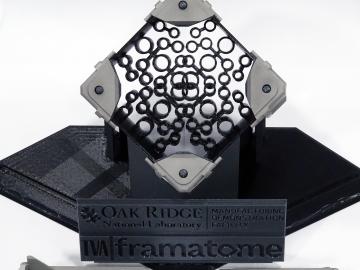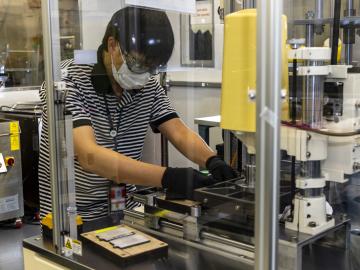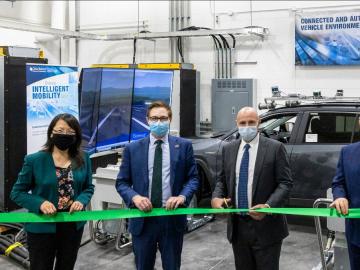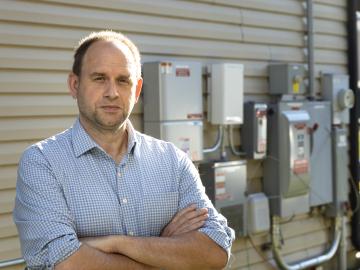
Filter News
Area of Research
- (-) Energy Science (154)
- Advanced Manufacturing (7)
- Biological Systems (1)
- Biology and Environment (47)
- Biology and Soft Matter (1)
- Building Technologies (3)
- Computational Biology (2)
- Computational Engineering (1)
- Computer Science (4)
- Electricity and Smart Grid (1)
- Energy Sciences (1)
- Fuel Cycle Science and Technology (1)
- Functional Materials for Energy (2)
- Fusion and Fission (48)
- Fusion Energy (17)
- Isotope Development and Production (1)
- Isotopes (29)
- Materials (136)
- Materials Characterization (1)
- Materials for Computing (20)
- Materials Under Extremes (1)
- National Security (31)
- Neutron Science (47)
- Nuclear Science and Technology (39)
- Nuclear Systems Modeling, Simulation and Validation (1)
- Quantum information Science (2)
- Supercomputing (57)
- Transportation Systems (2)
News Topics
- (-) Biomedical (6)
- (-) Buildings (38)
- (-) Cybersecurity (8)
- (-) Energy Storage (71)
- (-) Fusion (1)
- (-) Isotopes (1)
- (-) Materials Science (26)
- (-) Nuclear Energy (7)
- (-) Partnerships (12)
- (-) Polymers (11)
- 3-D Printing/Advanced Manufacturing (79)
- Advanced Reactors (6)
- Artificial Intelligence (8)
- Big Data (5)
- Bioenergy (26)
- Biology (11)
- Biotechnology (4)
- Chemical Sciences (14)
- Clean Water (8)
- Composites (17)
- Computer Science (25)
- Coronavirus (12)
- Critical Materials (9)
- Environment (54)
- Exascale Computing (2)
- Fossil Energy (2)
- Frontier (2)
- Grid (39)
- High-Performance Computing (6)
- Hydropower (3)
- Machine Learning (7)
- Materials (35)
- Mathematics (2)
- Mercury (3)
- Microelectronics (1)
- Microscopy (8)
- Molten Salt (1)
- Nanotechnology (8)
- National Security (5)
- Neutron Science (11)
- Physics (1)
- Quantum Science (2)
- Security (6)
- Simulation (4)
- Space Exploration (3)
- Statistics (1)
- Summit (4)
- Transportation (66)
Media Contacts

The Transformational Challenge Reactor, or TCR, a microreactor built using 3D printing and other new advanced technologies, could be operational by 2024.

Soteria Battery Innovation Group has exclusively licensed and optioned a technology developed by Oak Ridge National Laboratory designed to eliminate thermal runaway in lithium ion batteries due to mechanical damage.

Four research teams from the Department of Energy’s Oak Ridge National Laboratory and their technologies have received 2020 R&D 100 Awards.

ORNL and Department of Energy officials dedicated the launch of two clean energy research initiatives that focus on the recycling and recovery of advanced manufacturing materials and on connected and

The combination of bioenergy with carbon capture and storage could cost-effectively sequester hundreds of millions of metric tons per year of carbon dioxide in the United States, making it a competitive solution for carbon management, according to a new analysis by ORNL scientists.

Joe Hagerman, ORNL research lead for buildings integration and controls, understands the impact building technology innovations can have during times of crisis. Over a decade ago, he found himself in the middle of one of the most devastating natural disasters of the century, Hurricane Katrina.

Five researchers at the Department of Energy’s Oak Ridge National Laboratory have been named ORNL Corporate Fellows in recognition of significant career accomplishments and continued leadership in their scientific fields.

Oak Ridge National Laboratory scientists seeking the source of charge loss in lithium-ion batteries demonstrated that coupling a thin-film cathode with a solid electrolyte is a rapid way to determine the root cause.

Ada Sedova’s journey to Oak Ridge National Laboratory has taken her on the path from pre-med studies in college to an accelerated graduate career in mathematics and biophysics and now to the intersection of computational science and biology

Oak Ridge National Laboratory researchers have developed a thin film, highly conductive solid-state electrolyte made of a polymer and ceramic-based composite for lithium metal batteries.


